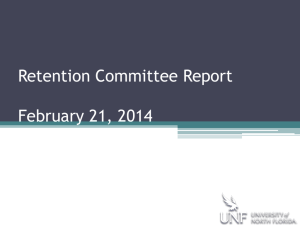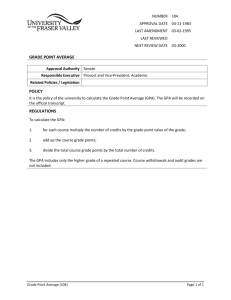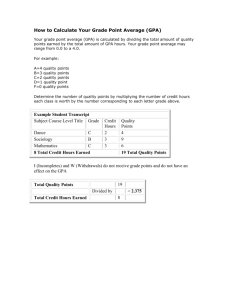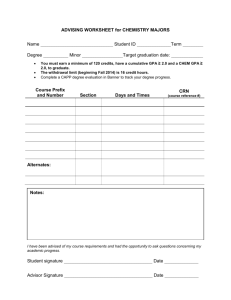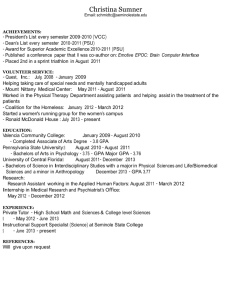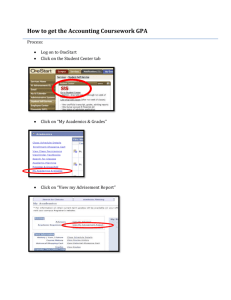Do or Do Not* There Is No Try: The Quest for Library Value
advertisement
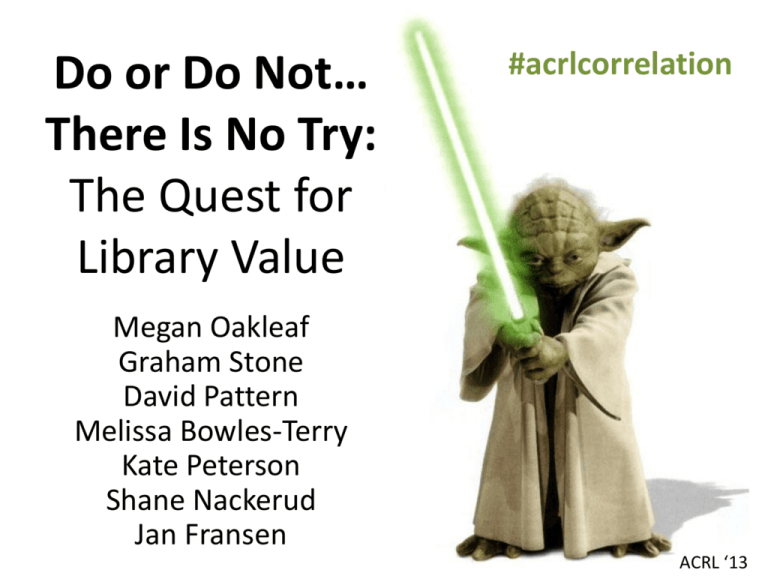
Do or Do Not… There Is No Try: The Quest for Library Value #acrlcorrelation Megan Oakleaf Graham Stone David Pattern Melissa Bowles-Terry Kate Peterson Shane Nackerud Jan Fransen ACRL ‘13 Introduction Megan Oakleaf http://meganoakleaf.info moakleaf@syr.edu Image source: http://nanozen.info/wp-content/uploads/2010/03/yoda.jpg ACRL ‘13 www.acrl.org/value Context Few libraries exist in a vacuum, accountable only to themselves. There is always a larger context for assessing library quality, that is, what and how well does the library contribute to achieving the overall goals of the parent constituencies? (S. Pritchard 1996) Conceptions Inputs/ Outputs Service Quality Commodity Impact Value Competing Alternatives Satisfaction Use Return-onInvestment (p 20) Institutional Impacts Report Recommendations • Determine what libraries enable users to do. • Develop systems to collect data on individual library user behavior, while maintaining privacy. • Record and increase library impact on student enrollment, retention, graduation rates, grade and test achievement, learning outcomes, “student experience”, job success, etc. Data, Evidence, & Proof “Not only do stakeholders count on higher education institutions to achieve their institutional goals, they also require them to demonstrate evidence that they have achieved them. The same is true for academic libraries; they too must provide evidence of their value.” (VAL Report,p 26) Student Enrollment Student Retention Student Graduation Rates Student Success Student Achievement Student Learning Student Experience Faculty Teaching Workbook Activity # 26 Which of these library services/resources impact which campus needs/goals/outcomes? Other: Physical Space Special Collections & Archives Collections Acquisitions ILL Reserves Circulation Instructional Services Reference Service LIBRARY IMPACT MAP Correlations http://meganoakleaf.info/valresearchquestions.pdf The Question of Causation • Umm…you can’t actually demonstrate causation, only infer it. • Do we have the capability to isolate all variables? • Do we have the need to say we are the only ones contributing to outcomes? • Is it enough to describe the profile of successful students and seek to increase students that emulate those attributes? • What is our goal? – If it’s to “prove,” then we may “need” causal data. – If it’s to improve, we don’t. University of Huddersfield Graham Stone David Pattern Image source: http://nanozen.info/wp-content/uploads/2010/03/yoda.jpg ACRL ‘13 Using Usage Data since 2005… …to improve existing services …to gain insights into user behaviour …to measure the impact of the library Library Impact Data Project Phase I (Feb-Jul 2011) To support the hypothesis that… “There is a statistically significant correlation across a number of universities between library activity data and student attainment” Library Impact Data Project 1 Original data requirements • For each student who graduated in a given year, the following data was required: – Final grade achieved – Number of books borrowed – Number of times e-resources were accessed – Number of times each student entered the library, e.g. via a turnstile system that requires identity card access – School/Faculty Did we prove the hypothesis? • The relationship and variance means that you can believe what you see • And you can believe it across a range of data – Subjects – Partners • So library usage does impact on students attainment 100 83 80 70 65 60 60 45 41 40 30 27 20 0 1 2:1 MetaLib logins 2:2 books borrowed 3 Library Impact Data Project Phase II (Jan-Oct 2012) Library Impact Data Project Phase II (Jan-Oct 2012) • Phase I looked at over 33,000 students across 8 universities • Phase II looks at around 2,000 FT undergraduate students at Huddersfield Library Impact Data Project 2 Additional data • We had some new library usage metrics which weren’t available during Phase I – – – – Demographics Overnight usage Off campus usage The number of e-resources accessed • as distinct from the hours spent logged into e-resources • the number of e-resources accessed 5 or more times • the number of e-resources accessed 25 or more times. Library usage Ethnicity Library usage Country of domicile Library usage Aggregated subject groups Library usage Retention • Looking at one year of data for every student • Using a cumulative measure of usage for the first two terms of the 2010-11 academic year • Only looking at people who dropped out in term three • All the students included in this study were at the university in the first two terms, and they have all had exactly the same opportunity to accumulate usage. Library usage Retention Number of e-resources accessed Depth and breadth Other factors Value added • Rank entry points and final grade as percentage • Does the difference correlate with measures of usage? • WARNING! This needs further testing! • Methods are untried • Missing data • Initial results are very encouraging Going forward @Huddersfield • Identifying retention issues and our impact on lowering them as part of a University dashboard • Look at specific subjects in order to work towards: – A best practice toolkit for information skills sessions – Further understanding by holding focus groups with target areas • Create an action plan to engage with academic colleagues • Showing value for money and the impact of the service on the student experience Going forward @a national level • An analytics service providing libraries with actionable data to transform the services and support institutions provide to students and researchers JiscLAMP Library Analytics and Metrics Project • The project will develop a prototype shared library analytics service for UK academic libraries – Envisioned as a data dashboard – To enable libraries to capitalise on the many types of data they capture in day-to-day activities – To support the improvement and development of new services and demonstrate value and impact in new ways across the institution • A partnership between Jisc, Mimas (University of Manchester) and the University of Huddersfield References • Library Impact Data Project blog – http://library.hud.ac.uk/blogs/projects/lidp/ • JiscLAMP – http://jisclamp.mimas.ac.uk/about-lamp/ • Stone, Graham and Ramsden, Bryony (2013) Library Impact Data Project: looking for the link between library usage and student attainment. College and Research Libraries. Available as pre-print • Stone, Graham and Collins, Ellen (2013) Library usage and demographic characteristics of undergraduate students in a UK university. Performance Measurement and Metrics, 14 (1). Available as pre-print University of Wyoming Melissa Bowles-Terry ACRL ‘13 Melissa Bowles-Terry Instruction & Assessment Coordinator mbowlest@uwyo.edu The Correlation A statistically significant difference in GPA between graduating seniors who had library instruction in upper-level courses and those who did not. Melissa Bowles-Terry, “Library Instruction and Academic Success: A Mixed-Methods Assessment of a Library Instruction Program,” Evidence Based Library and Information Practice 7, 1 (2012): 82-95. Process • 4,489 transcripts of students who entered UW between 2005-2007 and graduated 2006-2011, excluding graduate & professional students • Dataset from registrar: classes taken, grades, major at entry, major at graduation, GPA at graduation, sex • Compared transcript data with internal library instruction records and sorted students into groups based on level of library instruction Comparison groups MEAN GPA Group 1: Upper-level library instruction Group 2: Freshman-level library instruction Group 3: No library instruction 3.289 3.247 3.214 Now what? • Developing a tiered information literacy program • Argument for not “front-loading” library instruction in freshman year • Identifying departments that don’t currently use library instruction The bigger picture Image source: http://www.flickr.com/photos/andrewmalone/2177355189/ University of Minnesota Kate Peterson Shane Nackerud Jan Fransen ACRL ‘13 University of Minnesota-Twin Cities Jan Fransen (fransen@umn.edu) Shane Nackerud (snackeru@umn.edu) Kate Peterson (katep@umn.edu) http://blog.lib.umn.edu/ldss/ Project Team: Jan Fransen Kristen Mastel Shane Nackerud Kate Peterson David Peterson Krista Soria Correlations for First Year Undergraduates in 2011-12 • Statistically significant positive difference in GPA for library users vs. non-library users • Statistically significant relationship between library use and retention to Fall 2012 • Statistically significant relationship between library use and both Scholarship and Academic Engagement, as measured by the SERU survey How we found it: Layers of Data Office of Institutional Research Performance Data Term and Cum GPA, Retention Office of Institutional Research Demographics Data College, Level, Major, Gender, Ethnicity, Age Libraries Data (13 Access Points) Circulation, Digital, Instruction, Reference, and Workstation Any (trackable) Library Use • Circulation (including ILL and renewals) • Digital (website, e-journal, database, e-book) • Reference (online and consulting, when an ID was captured) • Instruction (workshops, course-integrated, Intro to Library Research) • Workstation (our only “library as place” measure) Demographics by themselves illustrate big and important differences between colleges Percent of Undergrads Using Library 100% College of Biological Sciences College of Science and Engineering 90% 80% 82% 81% 81% 79% 70% 78% 74% 60% 63% 50% 40% 30% 20% 10% 0% College of Biological Col of Food, Agr & Nat Col of Educ/Human College of Liberal Arts Sciences Res Sci Development College of Design Carlson School of Management College of Sci & Engineering Undergrad Circulation Usage 100 90 80 70 60 College of Design 50 40 37.23 30 27.64 20 17.01 18.34 18.17 14.19 10 12.82 0 CBS CFANS CEHD CLA CDES CSOM CSE Layers of Data Office of Institutional Research Performance Data Term and Cum GPA, Retention Office of Institutional Research Demographics Data College, Level, Major, Gender, Ethnicity, Age Libraries Data (13 Access Points) Circulation, Digital, Instruction, Reference, and Workstation Undergrad Term GPA - Fall 2011 Term 3.60 3.40 3.20 GPA 3.00 2.80 2.60 2.40 2.20 2.00 Carlson School of Management Col of Educ/Human Development Col of Food, Agr & Nat Res Sci College of Biological Sciences College of Design College of Liberal Arts College of Sci & Engineering No Library Use 3.15 3.00 2.92 3.11 2.92 2.86 2.94 Library Use 3.30 3.16 3.14 3.30 3.22 3.13 3.13 Inferential Analyses • First-year students (non-transfer, n = 5,368) • Examined three outcomes: – Grade Point Average – Retention – SERU indicators for Academic Engagement and Scholarship • Many ways to slice the data: – Any use of the library – Type of library use – Frequency within type of library use Other Characteristics Considered • Use of library (71.3%) • Demographics: – Gender (F = 47.8%) – Race/ethnicity (SOC= 18.4%) – Pell grant (22.3%) – Veteran status (.6%) – First-generation (25.9%) • College environment: – Freshmen seminar (27.8%) – Access to Success program (8.8%) – Dorm (85.2%) • Prior academics – ACT/SAT scores (M = 27.49) – AP credits (n = 3137, M = 8.73) GPA Results Controlling for demographics, college environment, and prior academic variables: • For Fall 2011, using the library at least once was associated with a .23 increase in students’ GPA holding other factors constant • For Fall 2011, a one-unit increase in types of use was associated with a .07 increase in GPA • Less difference in Spring 2012, but still a significant positive correlation Retention Results Controlling for the same variables, we examined retention: • Fall 2011: Students who used the library at least once were 1.54 times more likely to re-enroll for Spring 2012 • Spring 2012: Students who used the library during their first year were 2.075 times more likely to reenroll for Fall 2012 Additional Retention Results • Fall 2011: Students who had “Intro to Library Research II” library instruction were 7.58 times more likely to re-enroll for Spring 2012 • Spring 2012: Students enrolled in courses that included library instruction were 1.389 times more likely to re-enroll for Fall 2012 • Database use had a significant positive correlation for both semesters Student Experience in a Research University (SERU) Survey • Developed by the Center for Studies in Higher Education and administered to all degreeseeking U of M undergrads • Combined library data with SERU responses • FY Students who used the library had higher academic engagement and higher scholarship indicators on the SERU inventory SERU: How often have you… • Scholarship – Examined how others gathered and interpreted data and assessed the soundness of their conclusions – Reconsidered your own position on a topic after assessing the arguments of others – Incorporated ideas or concepts from different courses when completing assignments – Used facts and examples to support your viewpoint • Academic Engagement – – – – – – Asked an insightful question in class Contributed to a class discussion Interacted with faculty during lecture class sessions Brought up ideas or concepts from different courses during class discussions Had a class in which the professor knew or learned your name Talked with the instructor outside of class about issues and concepts derived from a course – Found a course so interesting that you did more work than was required What have we done with these results? Actions We’ve Taken • Used in our campus-wide Orientation messages • Highlighted in College of Science & Engineering recruiting event • Referenced in curriculum conversations • Part of reboot of Intro to Library Research • Deeper analysis of data for specific colleges • Exploring evidence of the most effective use of staff time (Library Course Pages, instruction) Conversations • Shown and explained our results to stakeholders and potential partners on campus – Libraries/University leadership – Faculty Senate Library Committee • Seen as “promising” • Led more to valuable conversations than to concrete actions Next Steps • Working to share with campus • Longitudinal • Data collection – Never ending battle – Easier we make it for patrons…harder for us • Authentication system • Discovery system coming • VPN usage unknown Questions? ACRL ‘13 Do or Do Not… There Is No Try: The Quest for Library Value #acrlcorrelation Megan Oakleaf Graham Stone David Pattern Melissa Bowles-Terry Kate Peterson Shane Nackerud Jan Fransen ACRL ‘13
